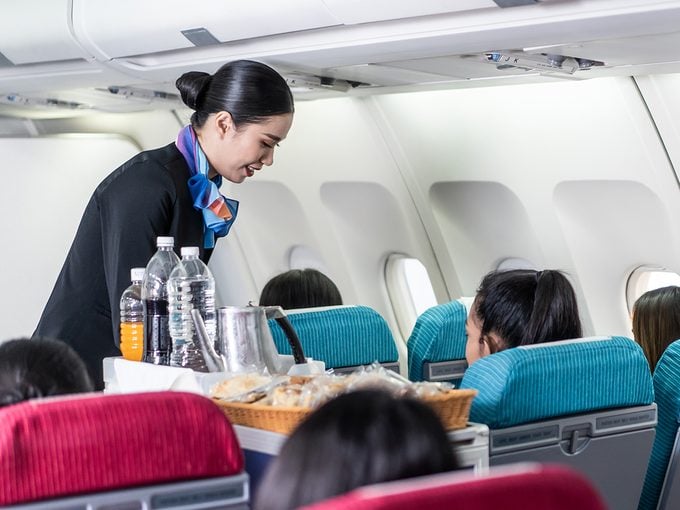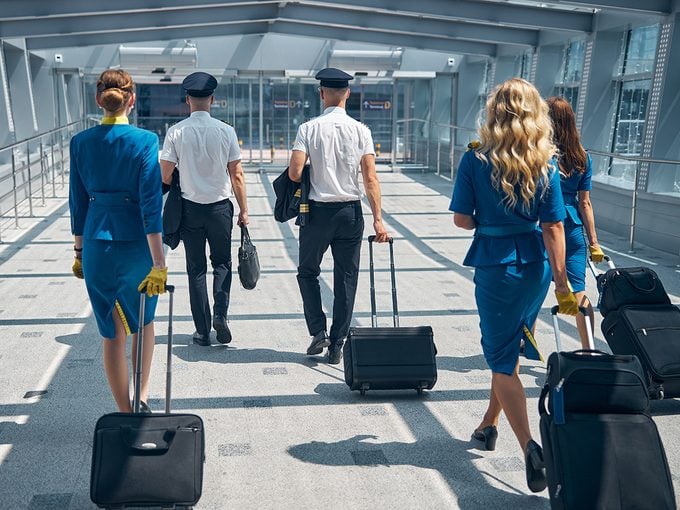Flight Attendants Use a Secret Language—Here’s How to Decode It

Learn these terms to keep up with your flight attendants on your next trip
Just about every industry has its own secret language, and if you listen carefully enough on your next flight, you might notice a shared vocabulary used by flight attendants. But while you may recognize terms like “galley” and “service,” there are likely quite a few words that are far less familiar.
Flight attendants rely on their special shorthand for effective and clear communication with one another. Don’t understand what they’re talking about? There’s no reason to feel left out! Your flight attendant may not reveal these industry terms, but Bobby Laurie will. He’s a former flight attendant and the current co-host of the travel show The Jet Set, and he has the inside scoop.
We asked him to decode the key terms flight attendants around the world use in the air and on the ground. Keep reading to learn the meanings behind some of their most common code words, and look out for them on your next flight.
Sign up for our Daily Digest newsletter for more travel tips, home hacks and humour, all week long.

Takeoff and landing
Flight attendants may toss around the following words as they ready the aircraft to launch into the air or land on the ground.
Red-eye
Here’s one you’ve probably heard before, but in case you need a refresher: A red-eye is usually an overnight flight that arrives early in the morning.
“It can be a good option when you don’t want to use a day of precious sightseeing time getting to your vacation destination,” says Laurie. Instead, you can sleep on the plane and start touring as soon as you check in to your hotel.
Pink-eye
Nope, we’re not talking about conjunctivitis here. A pink-eye flight takes off earlier than a red-eye (even if only slightly) but still occurs late at night. The difference: It’s not an overnight flight.
Holding pen
The holding pen is the area surrounding the gate where passengers wait to board, often standing around or milling about.
Runner
A runner is a passenger who is late to the airport or late from a connecting flight and is quite literally running to catch their departing flight.
Spinner
A spinner is a passenger who arrives without a seat assignment and stands in the middle of the aisle, confused and likely spinning to find their seat on the airplane.
Cross-check
A cross-check “refers to one flight attendant or two double-checking that the aircraft doors are armed or disarmed correctly before departure or before opening the door,” Laurie explains.
All call
“Generally, after a cross-check, there’s an all call, where all of the flight attendants get on the internal phone system and verify with each other that the aircraft doors have been correctly armed or disarmed,” Laurie says.
Jump seat
You may have noticed the special seat that flight attendants use at takeoff, landing and any point in the flight when they must be seated. This smaller seat makes it easy for flight attendants to jump to attention. The seat itself practically jumps into a folded position when the flight attendant stands.
Specials
According to Laurie, the term specials refers “to passengers who require special attention, such as those with mobility issues. But it also includes passengers who may require any sort of extra assistance.”
Don’t miss our guide to flying budget airlines in Canada.

In flight
Just as flight attendants have specific terms for takeoff and landing activities, they have flight code words to use once you’ve reached your cruising altitude.
Privo
Privo is “an all-encompassing term that references the provisioning on the aircraft: for the flight drinks, snacks, meals, etc.,” says Laurie.
U.M.
A U.M. (say each letter, not the filler word um) is an “unaccompanied minor traveling alone who is in the flight crew’s care,” Laurie says.
Blue room
Flight attendants often call the bathroom the “blue room” among themselves. The term is a reference to the blue liquid used in aircraft toilets.
Service
The term service “refers to any time the flight attendants put the beverage and meal carts together to go into the aisle and provide snacks or drinks to the passengers,” Laurie explains.
Galley
The galley is the aircraft’s small kitchen. Here, flight attendants prepare food, snacks and beverages.
Galley queen
This is a slang term for a flight attendant who is particular—even territorial—when it comes to the galley. The galley queen often prefers others stay out of their space.

Flight attendant life
Flight attendants don’t leave behind their secret language when the plane lands or they leave the airport. They use certain terms to talk about the flight attendant lifestyle.
RON
“If you’re flying on a late-night flight, during deplaning you might hear the crew asking if this is a RON, or a Remain Overnight,” Laurie says. “They’re asking whether or not the plane is done for the day and spending the night. In other words, it’s not going back out that evening. Sometimes it’s also called a terminator.”
Originator
An originator is “the first flight of the day from an airport,” says Laurie. “Airlines are very interested in making sure the originators depart on time because a delay on that flight would cause every flight that airplane operates for the day to be behind schedule.”
Turn
“A turn is a flight pairing that the flight attendants work where they depart from a city, fly to another, then go right back to the city they departed from,” Laurie explains. “In context, a Los Angeles-based flight attendant can do a D.C. turn, a San Francisco turn [or] a Seattle turn.”
Pairing or trip
“This refers to the one-, two-, three- or four-day schedule the flight attendant is currently operating,” says Laurie. You may hear a flight attendant talking about their “pairing of flights” or the “trip they’re on.”
Commuter
According to Laurie, a commuter is “a flight attendant who lives in a city other than the city in which they’re based with the airline, such as living in Las Vegas but working flights out of Los Angeles. They would fly to work—or ‘commute’ to work—before flying for work.”
Crash pad
A crash pad is an apartment that a group of flight attendants share. “It’s just a place to crash in between flights,” Laurie says. “It’s usually used by commuters who need a place to sleep between shifts when they don’t live in the same city they work in.”
It makes sense when you consider that commuting flight attendants wouldn’t want to shell out for a motel or hotel on days when their shifts don’t leave enough time to commute home for sleep.
Next, test your knowledge of these aviation terms.






